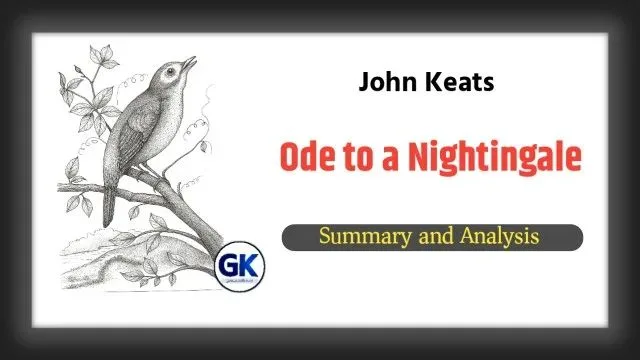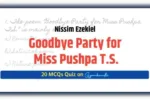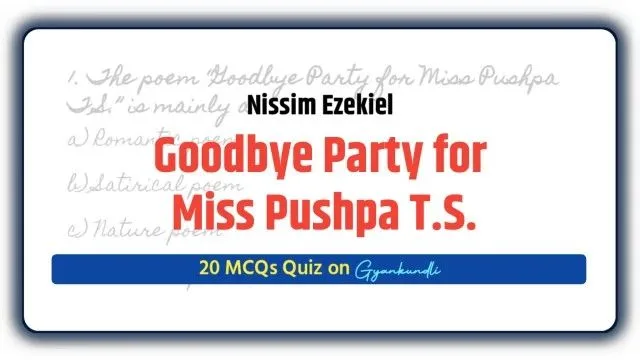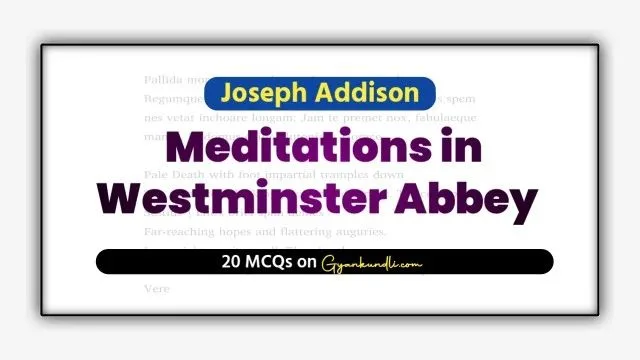Ode to a Nightingale is one of the finest poems written by John Keats, the great Romantic poet. It was composed in the spring of May 1819, which was the most creative year of his short life. According to Keats’s friend Charles Armitage Brown, the poem was written in a single morning while Keats was living with him at Wentworth Place, Hampstead, near London.
The inspiration for the ode came when a nightingale built its nest in the garden of Brown’s house. Keats often listened to the bird’s sweet song while sitting under a plum tree. Deeply moved by its music, he took a chair and a few sheets of paper into the garden, sat under the tree, and within a few hours wrote down this immortal poem.
The ode reflects Keats’s personal struggles—his failing health, the death of his brother, financial worries, and his unfulfilled love for Fanny Brawne. While listening to the bird, he felt transported into another world, free from human pain and sorrow. Thus, “Ode to a Nightingale” is both a record of his momentary escape into imagination and a meditation on life, death, and the power of art.
John Keats: Life and Works
John Keats (1795–1821) remains one of the most celebrated poets of the English Romantic movement. Though his life was tragically brief, his poetry has left a permanent mark on English literature through its sensuous imagery, emotional depth, and mastery of form.
Early Life
John Keats was born on 31 October 1795 in London to Thomas and Frances Jennings Keats. His father, who managed a livery stable, died when Keats was only eight years old, and his mother passed away of tuberculosis a few years later. Orphaned at a young age, Keats was placed under the guardianship of Richard Abbey, who sent him to a school at Enfield run by John Clarke. It was here that Keats developed his interest in literature and classical mythology.
Initially, Keats was apprenticed as a surgeon and apothecary, studying medicine at Guy’s Hospital in London. However, his passion for poetry gradually overtook his medical career, and he made the bold decision to devote himself to writing.
Literary Career
Keats’s earliest works appeared in The Examiner in 1816, encouraged by his friend Leigh Hunt. His first volume, Poems (1817), received little attention, but it signaled the arrival of a new voice. In 1818, he published Endymion, a long romantic poem beginning with the famous line, “A thing of beauty is a joy for ever.” Although critics harshly reviewed it, Keats’s poetic potential was undeniable.
The years 1818–1819 were the most productive of his short life. During this period, he composed many of his greatest works, including the celebrated odes such as:
- “Ode to a Nightingale”
- “Ode on a Grecian Urn”
- “To Autumn”
- “Ode on Melancholy”
- “Ode on Indolence”
These poems display Keats’s deep reflections on beauty, art, mortality, and the fleeting nature of human experience. His ability to fuse sensual imagery with philosophical meditation made his style unique among the Romantics.
Keats also produced narrative poems such as Isabella; or, The Pot of Basil and The Eve of St. Agnes, both inspired by medieval legends and Italian tales. His unfinished masterpiece, Hyperion, reveals his ambition to write epic poetry modeled on Milton.
Themes and Style
Keats’s poetry is distinguished by its rich imagery, sensuous appeal, and musical quality. He often dwelt on the tension between transience and permanence, mortality and immortality, reality and imagination. His concept of “Negative Capability”—the capacity to embrace uncertainty and doubt without seeking rigid answers—remains a hallmark of his poetic philosophy.
Later Life and Death
Keats’s health began to fail by 1819, as he showed signs of tuberculosis—the disease that had already claimed his mother and brother. Despite his illness, he continued to write with intensity, producing Lamia and The Eve of St. Agnes. In 1820, advised by doctors, he travelled to Italy for a warmer climate, accompanied by his friend Joseph Severn. Sadly, the change did not improve his condition. He died in Rome on 23 February 1821 at the age of only twenty-five. He was buried in the Protestant Cemetery in Rome, where his tombstone bears the famous inscription: “Here lies One whose Name was writ in Water.”
Legacy
Although Keats achieved little fame during his lifetime, his reputation grew rapidly after his death. Today, he is regarded as one of the finest lyric poets in the English language. His odes are often considered models of poetic craftsmanship, combining beauty of form with depth of thought. His ability to find eternal beauty in transient things continues to inspire readers across the world.
About the Poem Ode to a Nightingale
“Ode to a Nightingale” is one of the greatest poems of John Keats, written in May 1819 at Wentworth Place, Hampstead. The poem was inspired by the song of a nightingale that had built its nest in the garden. Listening to the bird’s music, Keats felt transported into a world free from pain and sorrow. He wrote the ode in a single day, capturing both his joy and his deep reflections on life and death.
In the poem, Keats compares the painful human life with the carefree song of the nightingale. He wishes for wine to escape from sadness but soon realises that imagination and poetry can take him higher than wine ever could. For a moment, he feels it would be beautiful to die while listening to the bird’s song, because the bird seems timeless and immortal. The song, he believes, has been heard by people of every age, from kings to peasants, even by Ruth in the Bible.
However, this dream does not last long. The word “forlorn” suddenly brings him back to his own world of suffering. The bird flies away, its music fades, and Keats is left wondering whether his experience was real, a vision, or just a dream.
The poem beautifully combines joy and sorrow, reality and imagination. It shows Keats’s ability to turn personal suffering into art. With its rich imagery, musical language, and deep thoughts, “Ode to a Nightingale” remains one of the finest examples of Romantic poetry.
Text of Ode to a Nightingale
My heart aches, and a drowsy numbness pains
My sense, as though of hemlock I had drunk,
Or emptied some dull opiate to the drains
One minute past, and Lethe-wards had sunk:
‘Tis not through envy of thy happy lot,
But being too happy in thine happiness,—
That thou, light-winged Dryad of the trees
In some melodious plot
Of beechen green, and shadows numberless,
Singest of summer in full-throated ease.
O, for a draught of vintage! that hath been
Cool’d a long age in the deep-delved earth,
Tasting of Flora and the country green,
Dance, and Provençal song, and sunburnt mirth!
O for a beaker full of the warm South,
Full of the true, the blushful Hippocrene,
With beaded bubbles winking at the brim,
And purple-stained mouth;
That I might drink, and leave the world unseen,
And with thee fade away into the forest dim:
Fade far away, dissolve, and quite forget
What thou among the leaves hast never known,
The weariness, the fever, and the fret
Here, where men sit and hear each other groan;
Where palsy shakes a few, sad, last gray hairs,
Where youth grows pale, and spectre-thin, and dies;
Where but to think is to be full of sorrow
And leaden-eyed despairs,
Where Beauty cannot keep her lustrous eyes,
Or new Love pine at them beyond to-morrow.
Away! away! for I will fly to thee,
Not charioted by Bacchus and his pards,
But on the viewless wings of Poesy,
Though the dull brain perplexes and retards:
Already with thee! tender is the night,
And haply the Queen-Moon is on her throne,
Cluster’d around by all her starry Fays;
But here there is no light,
Save what from heaven is with the breezes blown
Through verdurous glooms and winding mossy ways.
I cannot see what flowers are at my feet,
Nor what soft incense hangs upon the boughs,
But, in embalmed darkness, guess each sweet
Wherewith the seasonable month endows
The grass, the thicket, and the fruit-tree wild;
White hawthorn, and the pastoral eglantine;
Fast fading violets cover’d up in leaves;
And mid-May’s eldest child,
The coming musk-rose, full of dewy wine,
The murmurous haunt of flies on summer eves.
Darkling I listen; and, for many a time
I have been half in love with easeful Death,
Call’d him soft names in many a mused rhyme,
To take into the air my quiet breath;
Now more than ever seems it rich to die,
To cease upon the midnight with no pain,
While thou art pouring forth thy soul abroad
In such an ecstasy!
Still wouldst thou sing, and I have ears in vain—
To thy high requiem become a sod.
Thou wast not born for death, immortal Bird!
No hungry generations tread thee down;
The voice I hear this passing night was heard
In ancient days by emperor and clown:
Perhaps the self-same song that found a path
Through the sad heart of Ruth, when, sick for home,
She stood in tears amid the alien corn;
The same that oft-times hath
Charm’d magic casements, opening on the foam
Of perilous seas, in faery lands forlorn.
Forlorn! the very word is like a bell
To toll me back from thee to my sole self!
Adieu! the fancy cannot cheat so well
As she is fam’d to do, deceiving elf.
Adieu! adieu! thy plaintive anthem fades
Past the near meadows, over the still stream,
Up the hill-side; and now ’tis buried deep
In the next valley-glades:
Was it a vision, or a waking dream?
Fled is that music:—Do I wake or sleep?
Form, Meter and Rhyme Scheme of Ode to a Nightingale
Like most of Keats’s great odes, Ode to a Nightingale is written in ten-line stanzas. The structure of the poem gives it a musical and flowing quality. Keats uses mainly iambic pentameter (five stressed syllables in a line), which is the common meter of English poetry. However, the poem shows some variation. The eighth line of each stanza is shorter, written in iambic trimeter (three stressed syllables). This sudden drop in rhythm creates a pause and adds a special musical effect, almost like a gentle break in the song.
The rhyme scheme of each stanza is ABABCDECDE, and unlike some of Keats’s other odes (such as Ode on a Grecian Urn or Ode on Melancholy), the rhyme pattern remains the same in every stanza. This consistency reflects the continuous and unbroken song of the nightingale, which is central to the poem’s theme.
In terms of form, Keats’s ode combines lyrical beauty with reflective thought. The poem is not written in the traditional Pindaric or Horatian ode form, but in a unique variation created by Keats himself, often called the “Keatsian Ode.” This form balances personal emotion with philosophical reflection, making it a hallmark of Romantic poetry.
Summary of Ode to a Nightingale
At the start of the poem, Keats describes a heavy feeling of drowsiness that takes over his senses. It is not the dullness of wine or drugs, but a deep mood inspired by the nightingale’s enchanting song. He clarifies that this feeling is not envy of the bird’s happiness but rather a result of sharing in its joy. The nightingale’s music seems timeless and free, and Keats, absorbed in its melody, wishes he could join the bird’s carefree world.
He imagines drinking a draught of wine that would transport him away from the sorrows of human life into the forest where the bird sings. The idea of wine brings to his mind the “beaded bubbles” of a sparkling drink and the mirth of harvest celebrations in the countryside. Through this image, Keats contrasts the joy of simple rural life with the pain and weariness of human existence. He sees life as full of suffering: youth fades quickly, the old endure pain, and thinking too deeply about life only brings despair.
But then he realizes that he does not need wine to escape. His imagination itself can lift him higher than wine ever could. With the help of poetic vision, he soars above the trees into the moonlit sky. Though in reality there is only faint light around him, his imagination paints a scene where stars shine and flowers bloom. He cannot see the flowers clearly in the darkness, but from their fragrance and his knowledge of the season, he guesses which blossoms are around him.
In this atmosphere of darkness, fragrance, and music, the nightingale’s song grows even more powerful. Keats begins to reflect on death. He feels that it would be sweet to die at this very moment, to “cease upon the midnight with no pain,” while the bird continues to pour out its song, untouched by human mortality. The idea of death is not new to him; he admits he has often been “half in love with easeful Death.” Yet here, the song makes death seem beautiful and desirable, like drifting into eternal sleep.
Unlike human beings, the bird seems immortal. Its voice is not bound by time. Keats feels that this same song has been heard for generations: by kings and peasants, by people of ancient lands, and even by Ruth, the biblical figure, who wept in a strange land while longing for her home. The nightingale’s voice becomes a link between the past and the present, between human sorrow and natural joy.
However, the dream is suddenly broken. The word “forlorn” brings him back to the reality of his own troubled existence. The imaginative journey ends abruptly. The bird’s song fades into the distance, leaving Keats bewildered. He is uncertain about what has just happened—was it a vision, a dream, or merely a product of his fancy? He is not even sure whether he is awake or dreaming. The ode closes with this sense of confusion and disillusionment.
Analysis of Ode to a Nightingale
“Ode to a Nightingale” is one of Keats’s most celebrated odes, written in 1819, the most productive period of his short life. Structurally, the poem is a regular ode: it consists of eight stanzas, each of ten lines written in iambic pentameter, following a consistent rhyme scheme. Yet despite this formal structure, the poem gives the impression of free-flowing inspiration, almost like a rhapsody. It reads as if Keats is not recalling a past experience but directly sharing his thoughts and emotions with the reader while listening to the nightingale’s song.
The poem moves forward through a sequence of feelings—joy, longing, sorrow, and reflection—rather than a strict plan. Each stanza carries a new stage of thought, and one emotion naturally leads into another. In this way, the ode is less of a logical argument and more of an emotional journey.
Three central themes or ideas stand out in the ode:
Keats’s View of Human Life
For Keats, human life is filled with suffering, decay, and endless frustration. Youth passes quickly, age brings weakness, and life itself feels like a “vale of tears.” The brief happiness that the nightingale’s song brings only sharpens his awareness of life’s deep pain. Hearing the bird’s music makes him long for escape, because its song seems untouched by the miseries of human existence.
The Wish for Death
A strong theme of the poem is Keats’s preoccupation with death. He longs to leave behind the suffering of life, provided that death comes gently, like falling into sleep. This desire does not come from sudden despair but from his long history of pain and loss. His brother had recently died of tuberculosis; another brother had gone to America, leaving him lonely. His own health was weak, and he possibly already carried signs of the disease that would later claim his life. Financial troubles, harsh reviews of his poetry, and his inability to marry Fanny Brawne added to his frustrations. In such circumstances, death appeared not as terror but as release, a way to escape a world of pain. Yet, when the time came, Keats resisted death fiercely, even travelling to Italy in search of cure. Thus, the death-wish in the ode represents a momentary yet recurring feeling born out of his troubled life.
The Power and Limits of Imagination
Imagination, for Keats, is stronger than wine. Through poetry and fancy, he can lift himself into the bird’s world and escape reality. However, the ode also shows the limits of imagination. At first, it seems powerful enough to unite him with the nightingale’s immortal world, but soon it collapses, leaving him back in his ordinary, painful existence. Keats admits this failure when he says “fancy cannot cheat so well / As she is fam’d to do.” The imagination, though rich and powerful, cannot provide lasting escape. It can only offer temporary relief from life’s burdens.
Symbol of the Nightingale
The nightingale in the ode is more than a bird. On one level, it is a real creature whose song is timeless and beautiful. On another level, it symbolizes art and poetry itself—something that transcends human mortality and remains eternal. While human lives end in sorrow, the song continues across generations, connecting different times and people.
Imagery and Language
One of Keats’s greatest strengths is his imagery. In stanza II, he paints the picture of wine “with beaded bubbles winking at the brim,” evoking joy, sunshine, and harvest festivals. In stanza VII, he imagines Ruth “amid the alien corn,” homesick and sorrowful, yet comforted by the nightingale’s song. These vivid, sensuous images create layers of meaning that appeal to both the senses and the emotions. The poem’s musical quality—its flowing rhythms, soft sounds, and richness of tone—makes it one of the finest examples of Keats’s lyrical style.
Conclusion
The ode ends in uncertainty. The imaginative journey that had lifted Keats out of his world collapses with the word “forlorn.” The nightingale’s song fades, leaving him confused about whether his experience was dream, vision, or illusion. This unresolved ending reflects Keats’s larger philosophy of “Negative Capability,” where he accepts doubt and uncertainty without forcing an answer.
Ode to a Nightingale becomes a meditation on life, death, imagination, and art. It reveals Keats’s longing for escape from human suffering, his attraction to death, his faith and doubt in imagination, and his belief in the eternal power of beauty and poetry.
Discover more from Gyankundli
Subscribe to get the latest posts sent to your email.











